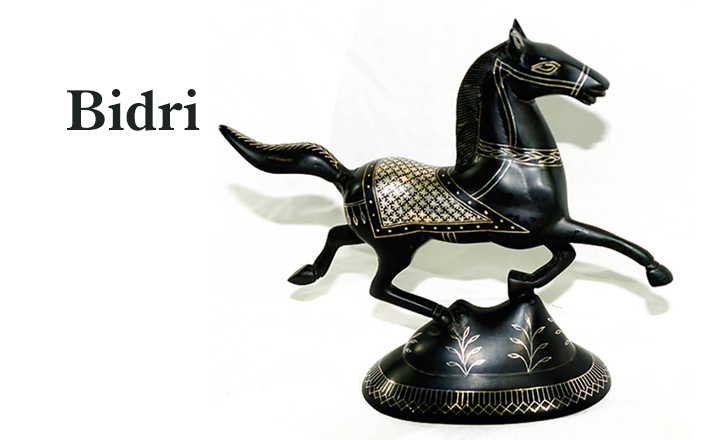Enticing Metalware Tradition of Nizam-E-Hyderabad

Bidriware is a renowned metal handicraft that derives its name from Bidar, presently in Karnataka. Bidriware represents a unique metal ware that is named after the region of Bidar, which was an important part of Hyderabad state before independence.
Origin
It was believed to have originated in 14th century AD during the reign of Bahmani Sultans who ruled Bidar in the 14th–15th centuries. Bidriware was first practiced in ancient Persia and it was later brought to India by the followers of Khwaja Moinuddin Chisti. The art form developed due to a mix of Persian and Arabic cultures followed by fusion with local style, resulted in a new and unique style of its own. The Nizam of Hyderabad introduced the art form in Aurangabad, which was part of Nizam’s Hyderabad state until 1948.
Process of Creating Bidriware
Bidriware is an eight-stage process. These are moulding, smoothening by file and the process of designing by chisel, followed by engraving using chisel and hammer where pure silver inlaying is done.
It is subjected to smoothening again, followed by buffing and finally oxidizing by making use of soil and ammonium chloride.
Bidriware is manufactured from an alloy of copper and zinc metals, in the ratio 1:16 by means of casting. Initially the presence of zinc ushers alloy a deep black color.
Firstly, a mould is created using soil and this is made malleable by adding castor oil and resin. The molten metal is later poured to create a cast piece followed by smoothened through filing.
The casting is further coated with a strong copper sulphate solution to gain a temporary black coating. Then the designs are etched freehand over this using a metal stylus. This is eventually secured in a vise and the Bidri craftsmen make use of small chisels to engrave the designs over this freehand etching. Fine wire or even flattened strips of pure silver are clearly hammered into the grooves.
The item is then filed and buffed, as well as smoothed to remove the temporary black coating. This results in a silver inlay that is not that clearly distinguishable compared to the gleaming metallic surface, which is now completely silvery white.
The Bidriware item is now completely set for a final blackening process. Here, makers use a special variety of soil that is available only in select places. This is mixed with ammonium chloride and water for producing a paste.
The mixture is further rubbed onto a heated Bidri surface that darkens the body without affecting the silver inlay. The paste is clearly rinsed, revealing a shiny silver design looking stunning and resplendent against the rest of black surface. The oil is applied as a finishing touch for the product to strengthen the matt coating. The finished product is now shining black with a brilliant silver inlay.
This native art form has also gained the Geographical Indications (GI) registry. Due to the striking inlay artworks, it is considered an important export item of India’s handicraft market. In some countries there is a great demand for the design of Persian roses and also the passages from the Holy Quran in the Arabic script. Bidriware is used for making paan holders, hookahs, and vases as well as bowls, ornament boxes, earrings, trays and other jewellery and showpiece items.
Traditional items made with this are figures of animals, birds as well as flowers. The artisans are skilled in creating many articles using Silver Filigree such as Spoons, cigarette cases, buttons boxes, ashtrays, jewellery, buttons pill boxes, paan dans and also perfume containers. They create special designs involving Peacock, parrots and fish which are clearly depicted in the perfume containers.
Karimnagar Silver Filigree also received the Intellectual property rights protection or Geographical Indication (GI) status in 2007. The delicate filigree work of Silver Filigree is therefore considered as a great craft which is widely popular.